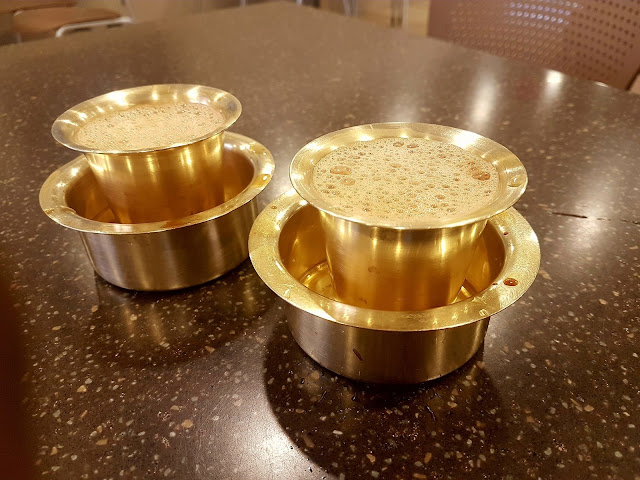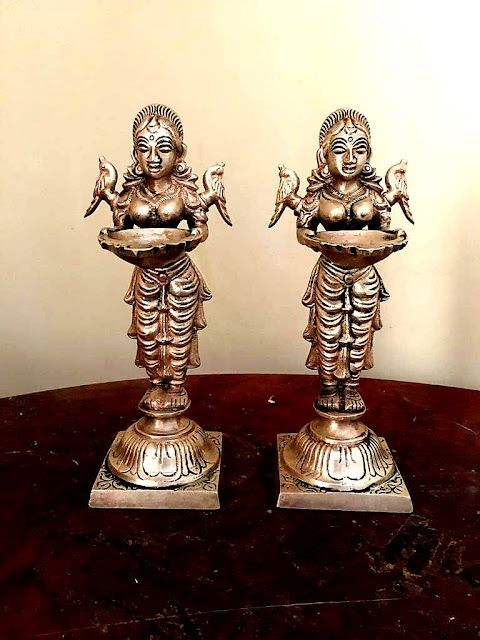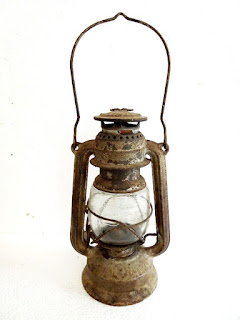Monday, 18 December 2017
Rukmani cooker
Cooking vessels of yore
About the Rukmani cooker:
About the Rukmani cooker:
One of my proud recent find is the legendary Rukmani Patented brass cooker of the 1940's the forefather of all cookers. First impression the cooker itself looks like a large thooku satti but on careful observation one can find the difference in material, make and markings in it, with numerous attachments all enclosed within it makes it super heavy than it looks, but its an ease to transport all the contraptions inside a vessel which can be carried along.
Working Principle:
The Rukmani cooker works on the principle of double boiling where the resultant heat with steam generated is used in cooking foods without pressure on a prolonged slow flame cooking process, there by retaining maximum nutrition along with taste in the foods cooked.
Components:
The inner vessels are all marked as RCC which stands for Rukmani Cooker Company are all made of brass coated with tin to prevent brass tarnishing the foods cooked, while the cooker itself is pure brass. Totally there are three tier tiffin carrier type vessels which fits one over the other meant for veggies boiling with the lower most vessel having a basal stand incorporated in the vessel itself, apart from it there is a small vessel for lentils and pulses boiling, and a large size vessel reaching the size of cooker itself is meant for rice cooking, the main body of the cooker is filled with water to 3/4th capacity then a brass vessel fitting the main vessel is lowered in it so the water gets trapped in between the body and the vessel forming a jacketed layer of hot water and steam when heated, then the respective food laden vessels are lowered in to it with lid closed securely the cooker is placed on a stove, as the foods are cooked over slow flame gently retaining maximum nutrition with flavours sealed in, the set also has a small round flat ladle which is used to dish out the prepared foods.
Uses:
Uses:
Rukmani cooker was an expensive offering among other traditional cooking vessels of those times and thats the reason for the rarity in finding of these cookers, they are bought by the affluent for daily home cooking and make shift cooking like picnics, pilgrimages, tours and by those who stayed out of home in hostels.. Now they find a place in museums sitting silent witnesses of their indispensable service in glorious past..
Sunday, 10 September 2017
Prabhavali or Thiruvachi
The Prabhavali or Prabhai is the most important accent to an idol which mimics the aura of the presiding deity it shadows and gives it a powerful stance and an air of supreme divinity. The intricate etchings of the arch are symbolic of fire and this could be evident in many larger prabhavali there are provisions for lighting lamps, which was done in those days where electricity was not in use and the light from the lamps served to light up the idol so that the devotees would get a glimpse of the features.
Friday, 18 August 2017
Porcelain Jars from Colonial era
Porcelain Jars from Colonial era
Antique British Porcelain Chemical jars made by Pearson Pottery, Nottingham, England for transporting chemicals to colonial countries that's the reason for the twin tone colour denoting toxic contents but later the empty jars were sold for low price to Indians who used them for storing Salt, pickle, tamarind and other food stuffs because of the fact that they lasted long and they become so popular that even till date newly made porcelain jars also follow the same colour pattern without knowing what it really stands for..
.
Featured here are large jars from same era aged 180 years still stands against the test of time..
Authored by
Sridhar, MBA, MTM, MHRM.,
Founder - Indian Antique Quest
Antique Curio Etailer
Find us on:
facebook.com/pg/indiantiquest/shop
pinterest.com/indiantiquest/
instagram.com/indiantiquest/
pinterest.com/indiantiquest/
instagram.com/indiantiquest/
Write to us - indiantiquest@gmail.com
Attachments
Saturday, 8 July 2017
Paavai Vilakku - Damsel with the lamp
Traditional South Indian Votive oil lamp depicting a lady holiding a lamp with both hands is known by various names such as Paavai Vilakku / Kai Vilakku yendiya Kaarigai / Deepa Lakshmi / Vilakku lakshmi meaning “lamps held by woman in her hands” or "Damsel with the lamp"..It signifies an unique craft made by the Yavanas (The Greeks) from a mix of metals including gold mainly for the use at the Palace of Pandya kings.
The original Yavana (Greek) designed lamps can still be seen in very old temples both in metals and in stone carvings incorporated in to the main temple structure and still being lit regularly.
Spread of the craft:
Paavai vilakku concept and making spread across cultures through out the country due to their immense beauty & appeal as a result we can now see many styles in this lamp with slight variations, alterations and improvisations done to the original concept but without changing the basic design. So now every state of India had its own style of Paavai Vilakku
Concept and design:
It was said that most of these original paavai lamps were designed based on the queen and royal ladies as the model and that the reason most of the antique paavai has elaborate detailing in attire, make over and draped with jewelry and has the crown on its head this can be evidently seen on close observation..There are a few temples where one can see the king and queen both modeled for the paavai lamps as a couple holding lamps..
Paavai lamps in family:
Later the people who could afford made Paavai lamps designed them like the prominent female members of their family and passed the lamps across generations making them immortals and also symbolising them as family guiding angels..
Paavai Lamps in sects of hinduism:
Apart from it there are Paavai lamps designed for Shaivaites as Godess Meenakshi with parrot on her right shoulder and for Vaishnavites as Godess Aandal depicted with a parrot on her left shoulder.. also there is a common to both sect variant shown with parrot on both shoulders and also another variant without any parrot..
Reference of Paavai Vilakku in ancient tamil classical work:
யவனர் இயற்றிய வினை மாண்பாவை;
Greek designed intricate lamp;
கை ஏந்து ஐ அகல் நிறைய நெய்சொரிந்து,
Hand held compartment filled with Ghee,
பரூஉத் திரி கொளீஇய குரூஉத் தலைநிமிர் எரி,
Cotton slevers wick lit glows up straight like a proud head held high,
அறு அறு காலைதோறு, அமைவரப்பண்ணி,
Glows and burns all the night till the day,
பல் வேறு பள்ளிதொறும் பாய் இருள்நீங்க...
Lightens all the bedrooms dispelling the darkness...
(Reference: Classical tamil literary work
Wednesday, 21 June 2017
Soorya Palagai : South Indian carved wood wall panels
South Indian carved wood wall panels
These are traditional door atop wooden carved panels featuring various hindu mythological charecters and subjects, carved out from single block of wood, the type of work called as Nagasu pattern where in life like details are portayed bringing in the old world charm. The most famous subjects of these panels are Gajalakshmi, Meenakshi thirukalyanam, Dasavathara, Trinity of brahma, vishnu and shiva, etc..#indiantiquest
These are traditional door atop wooden carved panels featuring various hindu mythological charecters and subjects, carved out from single block of wood, the type of work called as Nagasu pattern where in life like details are portayed bringing in the old world charm. The most famous subjects of these panels are Gajalakshmi, Meenakshi thirukalyanam, Dasavathara, Trinity of brahma, vishnu and shiva, etc..#indiantiquest
Authored by
Sridhar, MBA, MTM, MHRM.,
Founder - Indian Antique Quest
Antique Curio Etailer
Find us on:
facebook.com/pg/indiantiquest/shop
pinterest.com/indiantiquest/
instagram.com/indiantiquest/
pinterest.com/indiantiquest/
instagram.com/indiantiquest/
Write to us - indiantiquest@gmail.com
Kal chatty or Kal pathiram: Stone cook wares of yore
What are the use of Stones in cooking? 1.May be as a grinding stone? 2. As a base for make shift fire cooking? 3. Crushing ginger garlic and aromatic tubers? Well if your answer was as above - Meet the Forefathers of all cooking vessels :
Proud to present 400 year old Antique Stone Cooking Vessels of our ancestors these are predecessors of Clay ware and Porcelain ware, Still usable but not for the faint hearted because even the smallest vessel weighs couple of Kilograms..The specialty of stoneware was that it retained most of the nutrients in cooking, secondly it requires no oil in cooking.
The stoneware's are mainly made from two stones namely Soap stone which is a soft light stone known for ease of carving and another made of unpolished granite known for its strength and durability.
Proud to present 400 year old Antique Stone Cooking Vessels of our ancestors these are predecessors of Clay ware and Porcelain ware, Still usable but not for the faint hearted because even the smallest vessel weighs couple of Kilograms..The specialty of stoneware was that it retained most of the nutrients in cooking, secondly it requires no oil in cooking.
The stoneware's are mainly made from two stones namely Soap stone which is a soft light stone known for ease of carving and another made of unpolished granite known for its strength and durability.
Authored by
Sridhar, MBA, MTM, MHRM.,
Founder - Indian Antique Quest
Antique Curio Etailer
Find us on:
facebook.com/pg/indiantiquest/shop
pinterest.com/indiantiquest/
instagram.com/indiantiquest/
pinterest.com/indiantiquest/
instagram.com/indiantiquest/
Write to us - indiantiquest@gmail.com
Manapen Manamagal Marapachi bommai - Auspicious wooden dolls for the Bride and Groom
Manapen Manamagal Marapachi bommai - Auspicious wooden dolls for the Bride and Groom

Marapachi dolls dressed as bride and groom given as wedding gifts to the newly weds, as an auspicious gift..The way these dolls are dressed depends upon the cultural background, ethnicity and region of the Wedded pair, typical styles include dothi and angavastra clad male dolls and saree draped female dolls., it is also customary to dress up the pair to look like Lord Balaji and Godess Padmavathy. These dolls enjoy VIP attention during Nava rathri golu where the mythology states that no golu is complete without Marapachi doll pair.
Authored by
Sridhar, MBA, MTM, MHRM.,
Founder - Indian Antique Quest
Antique Curio Etailer
Find us on:
facebook.com/pg/indiantiquest/shop
pinterest.com/indiantiquest/
instagram.com/indiantiquest/
pinterest.com/indiantiquest/
instagram.com/indiantiquest/
Write to us - indiantiquest@gmail.com
Hurricane lantern - The light of yesteryear
Hurricane lamp
Hurricane lanterns are known the World over for its versatility, mobility and reliablity, as the name signifies they withstand burning even amidst a hurricane. They are made from zinc-plated material which protects against corrosion. The special engineered burner operates with no flickering, or soot from the flame. These lanterns also feature a heat resistant Fire proof RGW globe that can withstand operation in the rain or snow, without cracking.
The lamp burner has a flat wick, usually made of cotton. The lower part of the wick dips into the fountain and absorbs the kerosene by capillary action; the top part of the wick extends out of the wick tube of the lamp burner, which includes a wick-adjustment mechanism. Adjusting how much of the wick extends above the wick tube controls the flame. The wick tube surrounds the wick, and ensures that the correct amount of air reaches the lamp burner. Adjustment is usually done by means of a small knob operating, which a toothed, metal sprocket is bearing against the wick. If the wick is too high, and extends beyond the burner cone at the top of the wick tube, the lamp will produce smoke and soot (un burned carbon). When the lamp is lit, the kerosene in the wick burns to produces a clear, bright, yellow flame. As the kerosene burns, capillary action in the wick draws more kerosene up from the fuel tank. All kerosene flat wick lamps use the dead flame burner design, where the flame is fed cold air from below and hot air exits above. The principle behind this lantern is cold air being circulated and fed through the tubes at the sides to the wick end thereby providing constant oxygen supply keeping the flame burning bright at the same time withstanding fierce wind flow. Flat wick lanterns burn brightest with kerosene fuel for which they are made for, but also work fine on clear lamp oil, Petrol and turpentine. The once important part of life now rests at connoisseurs homes as works of art...
The lamp burner has a flat wick, usually made of cotton. The lower part of the wick dips into the fountain and absorbs the kerosene by capillary action; the top part of the wick extends out of the wick tube of the lamp burner, which includes a wick-adjustment mechanism. Adjusting how much of the wick extends above the wick tube controls the flame. The wick tube surrounds the wick, and ensures that the correct amount of air reaches the lamp burner. Adjustment is usually done by means of a small knob operating, which a toothed, metal sprocket is bearing against the wick. If the wick is too high, and extends beyond the burner cone at the top of the wick tube, the lamp will produce smoke and soot (un burned carbon). When the lamp is lit, the kerosene in the wick burns to produces a clear, bright, yellow flame. As the kerosene burns, capillary action in the wick draws more kerosene up from the fuel tank. All kerosene flat wick lamps use the dead flame burner design, where the flame is fed cold air from below and hot air exits above. The principle behind this lantern is cold air being circulated and fed through the tubes at the sides to the wick end thereby providing constant oxygen supply keeping the flame burning bright at the same time withstanding fierce wind flow. Flat wick lanterns burn brightest with kerosene fuel for which they are made for, but also work fine on clear lamp oil, Petrol and turpentine. The once important part of life now rests at connoisseurs homes as works of art...
Authored by
Sridhar, MBA, MTM, MHRM.,
Founder - Indian Antique Quest
Antique Curio Etailer
Find us on:
facebook.com/pg/indiantiquest/shop
pinterest.com/indiantiquest/
instagram.com/indiantiquest/
pinterest.com/indiantiquest/
instagram.com/indiantiquest/
Write to us - indiantiquest@gmail.com
Subscribe to:
Comments (Atom)
Antique Rail adukku/ Kaasi Pathiram from Tamilnadu
Antique Rail adukku/ Kaasi Pathiram Antique Rail adukku/ Kaasi Pathiram/ Adukku Pathiram set, this is the original rail adukku, because 99% ...

-
Antique Rail adukku/ Kaasi Pathiram Antique Rail adukku/ Kaasi Pathiram/ Adukku Pathiram set, this is the original rail adukku, because 99% ...
-
. . One of the most common question i encounter is "How the spoon stand was used in those days??" Its quiet easy to ...






















































